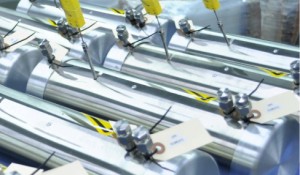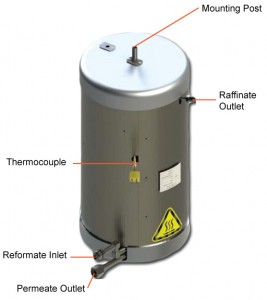[custom_frame_right] [/custom_frame_right]Power+Energy Hydrogen Separators produce ultra-high purity hydrogen from hydrogen rich gas streams for Fuel Cells. Each H2 separator may be custom designed to match the specific conditions of the customer’s application. Power+Energy manufactures H2 separators ranging in hydrogen output from 0.5 slpm, capable of feeding a 50W fuel cell, up to 1,200 slpm, capable of feeding a 120kW fuel cell.
[/custom_frame_right]Power+Energy Hydrogen Separators produce ultra-high purity hydrogen from hydrogen rich gas streams for Fuel Cells. Each H2 separator may be custom designed to match the specific conditions of the customer’s application. Power+Energy manufactures H2 separators ranging in hydrogen output from 0.5 slpm, capable of feeding a 50W fuel cell, up to 1,200 slpm, capable of feeding a 120kW fuel cell.
Our Separator technology is often used to extract the hydrogen from reformate streams generated by steam or auto-thermal reformers. In other cases P+E Separators extract H2 from a process by-product stream, from bio-gas (digesters, etc.) or from closed-circuit H2 recirculation systems.[custom_button text=”H2 Separator Brochure” title=”Hydrogen Separators” url=”http://powerandenergy.com/pdfs/hydrogen-separators.pdf” size=”medium” bg_color=”#FF5C00″ text_color=”#FFFFFF” align=”right” target=”_blank”]
Design and Operation
Power+Energy Hydrogen Separators use Micro-Channel Palladium Alloy Membranes to extract hydrogen from the feed stream. For mixed gas streams containing sulfur compounds, a sulfur-tolerant palladium alloy is used. In some applications, customers use a sweep gas, either nitrogen or steam, to boost the hydrogen recovery of the H2 separator.
[toggle_content title=”H2 Separator Operating Parameters”]
[custom_frame_right] [/custom_frame_right] Basic Terms:
[/custom_frame_right] Basic Terms:
- Reformate: Outlet gas mixture from Fuel Reformer
- Raffinate: Waste gas stream out from separator
- Permeate: Ultra-pure hydrogen stream from the separator
Operating Parameters:
- Maximum reformate inlet pressure = 300 psig
- Operating temp range = 300-500°C, recommended temperature = 400°C
- Maximum pressure differential = 180 psi (reformate press. – permeate press.)
- Maximum reverse pressure differential = 10 psi (permeate press. – reformate press.)
- Membranes should not be exposed to H2 when below 300 °C to avoid embrittlement.
- It is recommended that a backpressure regulator is installed in the raffinate line.
- Preheat membranes with steam, hot air or hot inert gas prior to flow of H2 or reformate.
- Purge membranes with steam or inert gas prior to allowing membranes to cool below 300°C.
- It is recommended to monitor the raffinate outlet gas temperature in order to ensure that the membrane temperature remains above 300 C while h2 containing gases are flowing through the separator.
[message type=”warning”]Caution: It is essential that catalyst particles from the reformer are prevented from entering the hydrogen separator.[/message] [/toggle_content]
Ordering Hydrogen Separators
Power+Energy will be pleased to design and manufacture H2 separators to meet your specific process condition. Please click here to launch our Hydrogen Separator Requirements Form. Complete the form, and a P+E Design Engineer will contact you.
[custom_button text=”Go to the Separator Information and Order Form” title=”Go to the Separator Information and Order Form” url=”http://www.powerandenergy.com/separator-reactor-order-form-information/” size=”large” bg_color=”#FF6600″ text_color=”#FFFFFF” align=”center” target=”_blank”]
Product Applications
[udesign_recent_posts title=”” category_id=”18″ num_posts=”10″ post_offset=”0″ num_words_limit=”23″ show_date_author=”0″ show_more_link=”0″ show_thumbs=”1″ thumb_frame_shadow=”1″ post_thumb_width=”100″ post_thumb_height=”80″]